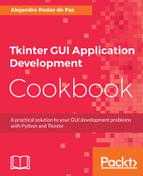Thanks to its clear syntax and the wide ecosystem of libraries and tools, Python has become a popular and general-purpose programming language. From web development to Natural Language Processing (NLP), you can easily find an open source library that fits the need of your application domain, and in the last instance, you can always use any of the modules included in the Python standard library.
The standard library follows the "batteries-included" philosophy, which means that it contains a large collection of utilities: regular expressions, mathematical functions, networking, and so on. The standard Graphical User Interface (GUI) package of this library is Tkinter, a thin object-oriented layer on top of Tcl/Tk.
Starting from Python 3, the Tkinter module was renamed to tkinter (with a lowercase t). It also affects to the tkinter.ttk and tkinter.tix extensions. We will dive into the tkinter.ttk module in the last chapter of this book, since the tkinter.tix module is officially deprecated.
In this chapter, we will explore several patterns for some basic classes of the tkinter module and some methods that are common to all widget subclasses.
